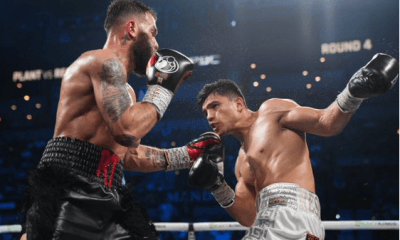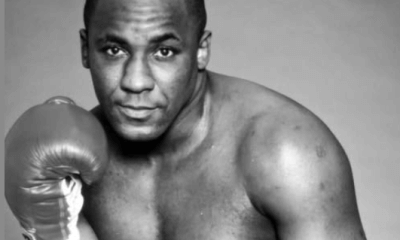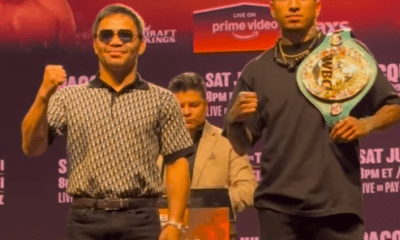Featured Articles
HOW HE DID IT Mayweather's Mastery Explained
Floyd Mayweather moved one step closer towards finishing his professional boxing career with an unbeaten record after clearly outpointing Saul “Canelo” Alvarez in what was the biggest boxing event of 2013 on Saturday night.
Prior to the fight, I believed Canelo's intelligence, size, power, patience, and explosiveness were destined to give Floyd his toughest outing since narrowly escaping with a “unanimous decision win” over Jose Luis Castillo back in 2002.
More than that, I did the unthinkable and picked Canelo to “shock the boxing world” and pull off an upset for the ages.
I was wrong.
Instead, it was more of the same for Floyd—and for all of us sitting watching at home or at ringside—as he routinely boxed his way to a majority decision victory in a fight devoid of any real action or drama. While Alvarez always carried the punch that could have potentially ended the fight at any given moment, he never really came close to breaking down Mayweather’s nonporous defense at any stage during the night.
Although it was far from a career best performance (as some have rashly claimed), Mayweather did put forth a quite beautiful display of boxing that included many of the nuances that set him apart from every single one of his current peers at the moment.
Very briefly then, rather than simply regurgitate many of Mayweather’s signature techniques and tendencies (i.e. rolling of the lead shoulder, fade counter etc.) that I previously discussed in part one of my two part pre-fight analysis, I shall instead be focusing on some of the more subtle features of Mayweather’s game that quite often go unnoticed.
Today I shall be taking a look at Floyd Mayweather’s understanding of range and his probing jab.
Often it is said that success in any endeavor depends upon being in the right place at the right time. This is especially true in boxing. Even if one knows thousands of techniques and can execute each one flawlessly, none will be of any use if they fail to reach the intended target.
When watching Mayweather in the ring, most seem to believe they are witnessing nothing but outrageous speed and reflexes, but the truth is that while Floyd has both of these in abundance, his dominance in the ring comes down to a mastery of what I believe to be—along with timing—the most important aspect of boxing: control of range.
Mayweather knows precisely how to position himself so that his attacks have the greatest probability of landing on his opponent. More importantly, he also knows how to position himself so that his opponent’s attacks have the least probability of landing on him.
Being able to manage distance in a fight doesn’t necessarily mean one must always keep the opponent on the outside. While this is obviously true if one is looking to keep the opponent on the end of a jab all night long, controlling the range of a fight can also have an adverse meaning.
A lot of people tend to think of staying out of range as being the safest place to be inside a boxing ring. Obviously being out of range is a good defensive measure, but in doing so, one may inadvertently place one’s self on the very end of the opponent’s punch, where it does the most damage. For example, because speed and power need room to generate, I’d consider being on the inside with Thomas Hearns a far safer place to be in as opposed to loitering on the outside where the difference between being out of range and being on the end of a right cross is just one short step.
This is where Mayweather’s appreciation of ring placement truly comes into its own.
Many criticized Canelo for employing a strategy that seemingly neglected his natural advantages in size and weight. However, for anyone who had seen him fight before, it was obvious that his best and most dangerous work was done at mid-range when throwing his imaginative combinations and when looking to land counters.
Instead of using his footwork to keep Canelo mobile and from getting set (which he did later on in the fight after Canelo began pressing the attack once he realized he wasn’t quick enough to try and counter Floyd in center ring), Mayweather spent the first part of the fight standing right in front of his man. From the opening bell, it was apparent that Mayweather’s initial plan was to get off first and restrict Alvarez’s ability to throw anything back in return. Slightly out of range, Mayweather would edge forward before connecting with either a jab or right hand lead, and then immediately force a clinch to prevent Alvarez from retaliating.
Mayweather searches for openings in Canelo’s guard.
Floyd threads a jab between Canelo’s gloves.
Anticipating Canelo’s counter, Floyd ducks underneath…
…and holds on, forcing the referee to intervene.
Mayweather continued to land stiff jabs and right hand leads on Alvarez. Most had expected Floyd to be on his back foot from the very beginning, but here he was, inching forward, getting off first, and smothering any chance Canelo had of throwing an effective counter—a tactic that nullified Canelo’s A-game and put a huge dent in his early confidence.
Mayweather closes in on Canelo.
Mayweather lands a straight right hand…
…then immediately dives underneath…
…and forces Canelo to hold.
Never really coming to terms with Floyd’s constant flirtation with the pocket, Alvarez always found Mayweather either too far away to be hit, or too close to be hit with his best weapons. Essentially, this was the story of the fight.
Alvarez is looking to create an opening.
Reacting to Canelo’s feint, Floyd pushes off his front foot and moves out of range.
Mayweather advances forward and re-enters the pocket.
Just as Canelo is thinking about going on the offensive, Mayweather lands a jab…
…instantly ducks underneath…
…and falls into a clinch, thus preventing any attempted counter or further attack from Alvarez.
In his treatise on boxing Championship Fighting: Explosive Punching and Aggressive Defense Jack Dempsey strongly emphasized that when it comes to the jab, the lead hand should be reserved almost exclusively for delivering what he termed “lead jolts” and should never be used for “fluffing” jabs that are used to “tap, slap, flick, paw or paint”.
Well sorry, Mr. Dempsey, but as Floyd has shown during many of his most recent outings, a light, non-contact “probing” jab can be a great way to offset the opponent’s timing and create openings.
What I find truly astonishing is that the world’s greatest pound-for-pound fighter is still evolving, becoming more and more unorthodox with each passing fight.
Floyd will, of course, step in behind a regular jab and use it for its typical purpose—to establish range and prevent the opponent from getting to the inside position—but Floyd now regularly uses a “blinding” or “flicker” jab (the terminology is far from universal) to occupy and manipulate his opponent’s guard in order to set up his straight rights and left hooks, of which, nobody seems to be able to defend against.
For further reading on Mayweather’s probing lead hand I suggest reading my post fight analysis on the Floyd Mayweather-Robert Guerrero fight. http://www.tss.ib.tv/news/articles-frontpage/16611-how-he-did-it-mayweathers-scintillating-display
Here is an example of Mayweather using his lead hand to serve as a distraction for his body jab, which in turn, is used to set up a follow-up attack:
Mayweather and Alvarez are posturing in the center of the ring.
Floyd distracts Canelo with a “blinding” jab.
Floyd drops low and lands a body jab. Notice how Canelo has lowered his guard to try and stuff it.
Mayweather takes advantage of Canelo’s low guard by following up with a right hand to the head.
Mayweather’s entrancing lead hand continued to befuddle Alvarez throughout the fight. Below is an example of Mayweather tapping Alvarez on the head, so that when Canelo retaliates, he affords Mayweather with a momentary opening that he can exploit.
Mayweather looks to distract Canelo with his lead hand.
Floyd touches the top of Canelo’s head with an extended lead glove.
Reacting to Mayweather’s unusual tactic, Canelo angrily swipes Mayweather’s lead glove away.
Mayweather takes advantage of Canelo’s defensive lapse and connects with a right hand down the middle.
Regardless of who he has ever fought or sparred with, I can guarantee that young Canelo will have never had anyone dare to stand right in front of him and try to tap him on the gloves or head in an attempt to pry open his guard. Below is yet another example of Mayweather’s antagonizing lead hand tactics.
Mayweather and Canelo are looking for openings.
Mayweather touches Canelo’s rear hand with his lead glove.
This time, Mayweather touches Canelo’s lead hand with his lead glove.
Taking the bait, Canelo tries to swat down Mayweather’s lead hand…
…and gets nailed with a hard right.
As these examples clearly illustrate, much of what Mayweather does inside the ring is just as much mental as it is physical. Floyd's unorthodoxy along with his elite level timing and understanding of range makes him nigh on impossible for today’s fighters to try and fathom out.
Right now, Mayweather looks as close to unbeatable as one can possibly get. Because of what is currently out there at the moment, it doesn’t look like his “0” will be going anywhere anytime soon.
-

 Featured Articles4 weeks ago
Featured Articles4 weeks agoA Night of Mismatches Turns Topsy-Turvy at Mandalay Bay; Resendiz Shocks Plant
-

 Featured Articles2 weeks ago
Featured Articles2 weeks agoAvila Perspective, Chap. 330: Matchroom in New York plus the Latest on Canelo-Crawford
-

 Featured Articles1 week ago
Featured Articles1 week agoVito Mielnicki Jr Whitewashes Kamil Gardzielik Before the Home Folks in Newark
-

 Featured Articles4 weeks ago
Featured Articles4 weeks agoRemembering the Under-Appreciated “Body Snatcher” Mike McCallum, a Consummate Pro
-

 Featured Articles4 weeks ago
Featured Articles4 weeks agoAvila Perspective, Chap 329: Pacquiao is Back, Fabio in England and More
-

 Featured Articles3 weeks ago
Featured Articles3 weeks agoOpetaia and Nakatani Crush Overmatched Foes, Capping Off a Wild Boxing Weekend
-

 Featured Articles3 weeks ago
Featured Articles3 weeks agoFabio Wardley Comes from Behind to KO Justis Huni
-

 Featured Articles2 weeks ago
Featured Articles2 weeks agoCatching Up with Clay Moyle Who Talks About His Massive Collection of Boxing Books
















